|
For the (impressive) raw specifications of the Samsung Omnia HD, see our original launch news post here. And here's Rafe's original detailed photo gallery, taken at MWC 2009.
The Omnia HD we were trying out was final
hardware and with recent (though not final) firmware. Of note on the
software front was that this still had debug code in (so it's
potentially going to be even faster) and that many of the third party,
licensed extras shown off at MWC weren't installed here.
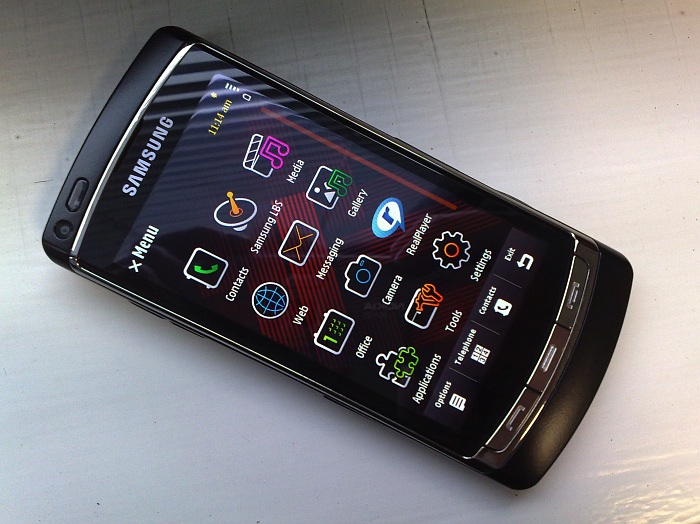
First impressions are of how tall the Omnia HD is. It's only 13mm
thick and no wider than, for example, the Apple iPhone, but it's quite
long, mainly due to the need to fit in the huge 3.7" capacitive, AMOLED
touchscreen. So the Omnia HD has just about the biggest screen of any
phone in the world, using the 'best' touch technology, with the
brightest display system. It all adds up to something of a stunning
experience. I thought the screens on my Nokia 5800 and Apple iPod Touch
were pretty stunning (indoors), but both were outshone for colour and
contrast by the OLED technology in the Omnia HD:
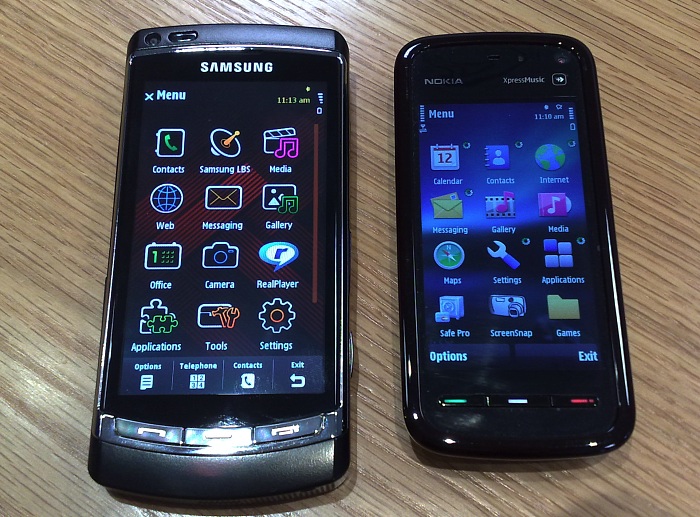
Omnia HD vs Nokia 5800
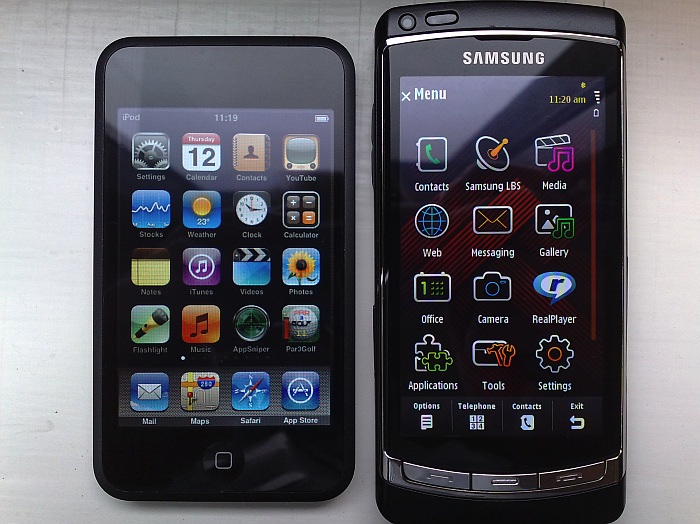
iPod Touch (same form factor/tech as iPhone) vs Omnia HD
Having used the resistive-screened Nokia
5800 extensively, I was keen to try the capacitive-screened Omnia HD.
As with the iPhone, the use of capacitive sensing means instant
response to a screen touch - there's no need to press down. Capacitive
screens also mean a tough outer glass front and, with the bright OLED
display underneath, and the use of a OMAP3 processor (with graphics
acceleration), makes for an utterly superb user experience. You touch
the screen, something happens. Immediately. Admittedly the Omnia is
going to cost twice the price of the Nokia 5800, but at least you can
see where the money's going.
I was particularly interested in typing on
the full-screen qwerty keyboard. With the better touch response and
with (physically) greater area per virtual key, I was expecting this to
work really well. Which is why both Rafe and I were utterly bamboozled
by the fact that our first attempts to type on the qwerty on-screen
keyboard resulted in gibberish.
The problem is that, like the Nokia 5800's
resistive screen, there's no multi-touch, so you have to completely
lift off one 'key' before starting to tap the next one. Try to go too
fast and there will be tiny overlaps and the capacitive screen then has
two inputs to process and gets the result spectacularly wrong. With the
5800 there's a margin of error in that you can start lifting off one
'key' while starting to tap the next and the worst that happens is that
you might miss a letter. On the Omnia HD, get even the smallest overlap
in timing and you generate bogus characters every time. By the end of
our day with the Omnia HD, I was starting to adjust and my last
attempts at typing were a lot more successful. But this still won't
stop me pleading with the programmers at Nokia and Samsung to pull
their finger out and implement drivers for multi-touch
(pseudo-multi-touch in the 5800's case - Nokia can email me for the
concepts and algorithms!) so that typing on a touch screen becomes fast
enough to be a viable alternative to a real keyboard.
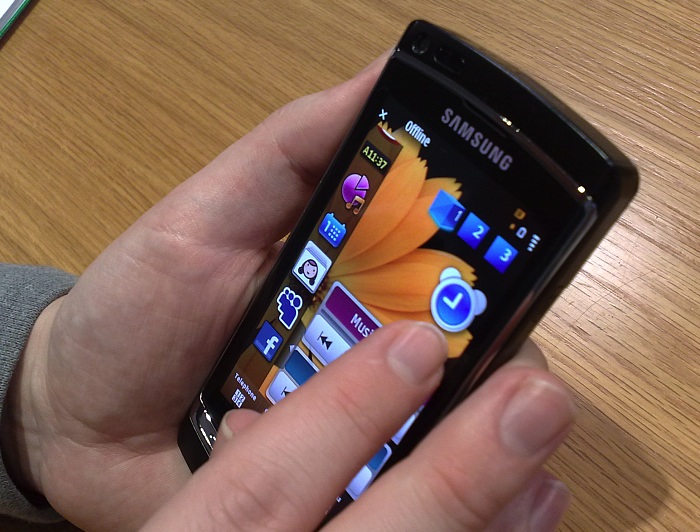
The TouchWiz home screen was something
that Rafe was particularly keen to try and I think it's fair to say
that both of us were moderately impressed with the slickness of it,
although many of the 'widgets' were sadly nothing more than shortcuts
to web sites, while many others were somewhat trivial in function.
Still, being able to completely customise up to three separate home
screens was rather nice and I especially liked the way you can swipe
from right to left to bring up the standard S60 menus (as an
alternative to pressing the middle hardware key). Rafe will be going
into TouchWiz in a lot more detail in a future part in this series.
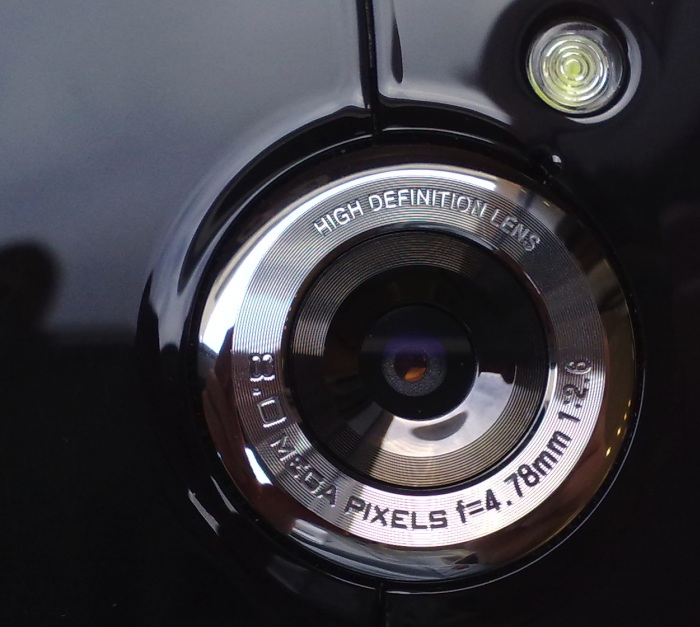
The next main attraction was the camera, of course. 8 Megapixels and
720p (HD) video recording. The first thing to notice is that there's no
lens cover or shutter, a bit of a disappointment. It's recessed far
enough not to be in danger of scratches, but it's still going to
collect dust like it's going out of fashion. A backwards step. The 8
megapixel stills sensor seems to be similar to that in the excellent
INNOV8 - results in my test photos weren't quite as good, but then the
firmware and camera algorithms aren't finalised yet and this is sure to
be an area that gets tweaked. Here's an example photo, taken on the
Omnia HD, click for the full 8 megapixel image:

Night-time flash is via single LED, but the low light responsiveness
of the phone's camera sensor does mean that you'll only need to resort
to flash when it's really quite dark. Still, you'd have thought a Xenon
flash would have made sense in a unit this well specified?
Video capture can be at a variety of resolutions:
- 720p (1280 by 720 pixels)
- 720 by 480 (the 16:9 widescreen version of VGA)
- 640 by 480 (VGA)
- 320 by 240 (QVGA)
Having experienced several Nokia Nseries phones which clearly had
trouble managing to encode video at full frame rate at VGA (naming no
names, but the N79 and N85 should look away now as likely
candidates...), plus bearing in mind the issues I've had with Samsung's
previous device, the INNOV8, which to this day can't keep captured
video in sync with the audio track, I was slightly sceptical about
whether the Omnia HD could cope with capturing, encoding and saving
video at 720p HD resolutions.
I was right to be sceptical, though again we should emphasise that
the firmware here is very much a work in progress. On the positive
side, the Omnia HD managed to capture video at 720 by 480 without
introducing any audio/video sync problems, so we've clearly moved on
from the INNOV8. The initial focus in video mode was still there and
very welcome, but the quality of the captured audio wasn't brilliant -
I suspect this is down to Samsung using cheaper microphones than Nokia
in this department. When we tried to record at full 720p, there was a
huge lag in the audio track - this is an area where Samsung are going
to have to pull out all the stops before release if the device's
headline feature isn't to become a laughing stock.
So that you can see the output from the Omnia HD for yourself, here
are two MP4 files from its camera. Again, bear in mind that this is
preproduction firmware:
720by480.mp4 (wide VGA, 12MB) and 720p.mp4 (HD, 720p, 23MB)
__________
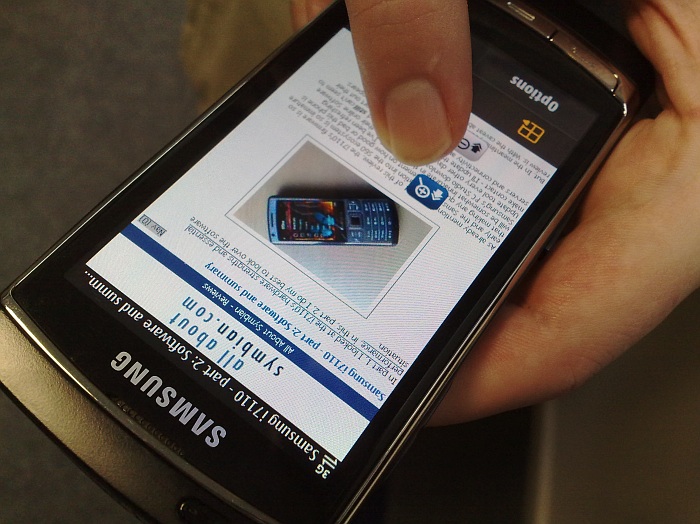
Working our way around the Omnia HD's interface, a lot of it was
quite familiar from the Nokia 5800, although there are numerous tweaks
that Samsung have added and which Rafe will be sharing in text and
video form over the next few weeks. One of the most interesting tweaks
we found (and shown above) was in Web, where tapping and holding brings
up a zoom control - swipe up or down and you dynamically change the
current page's zoom level. Pretty cool.
I experimented with video playback on the Omnia HD (I'd brought
along a selection of media files) and it played everything I threw at
it without complaining. The sound output was especially welcome, the
Omnia's speakers (on each end of the device, shown below) are almost as
loud as those on the Nokia N95 and 5800. Sound quality for music
playback was especially good, with Samsung's DNSe 2.0 system providing
some pretty advanced equalisation and enhancement functions - Rafe gave
this a big thumbs up, listening on his Ultimate Ears headset.
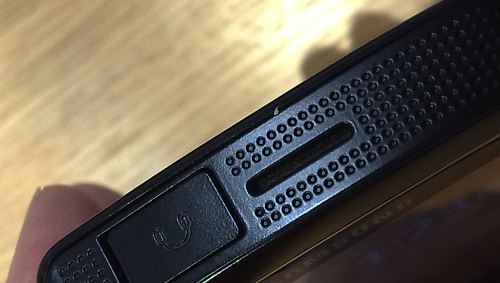
On the technical side, I noted that the Omnia HD had a whopping,
humungous 163MB of RAM free after booting. Whether this remains this
high for production models remains to be seen. There was also 8GB of
flash memory in a built-in mass storage disk (with a 16GB option in
production), plus microSD, of course.
The specifications of the Omnia HD are somewhat overwhelming. When I
first tried the INNOV8, early in 2008, I remember remarking how this
had everything that could possibly be put into a phone. And here we are
a year later with massive high brightness screen, capacitive touch,
digital compass, FM transmittter, HSUPA, DNSe 2.0 and more, all over
and above what the INNOV8 offered.
Holding the Omnia HD in the hand, it's large enough that you think
of it very much in the vein of the iPhone (or the upcoming Nokia N97),
i.e. it screams "I'm not just a phone", whereas the Nokia 5800 perhaps
merely raises its voice to suggest the same. It has similar problems to
the 5800 in that the screen is unreadable in full-on, direct sunlight,
in that it attracts fingerprints, and in that there's no multi-touch
(yet) to speed text input. And Samsung have, of course, got the
traditional challenge from me to follow up some ground-breaking
hardware with bug-free, mature software and services. The INNOV8 was
perhaps a little too early in their software and services 'curve' and
suffered at reviewers' hands as a result. Maybe the Omnia HD is the
right product at the right time?
Samsung just made their pitch for the Symbian top-end with the
announcement of the Omnia HD (a.k.a. the i8910). This features a full
touch interface running S60 5th Edition, a 3.7" AMOLED display, plus a
camera unit with 8mp capture and full 720p HD video recording. Photos,
comment and specs below.
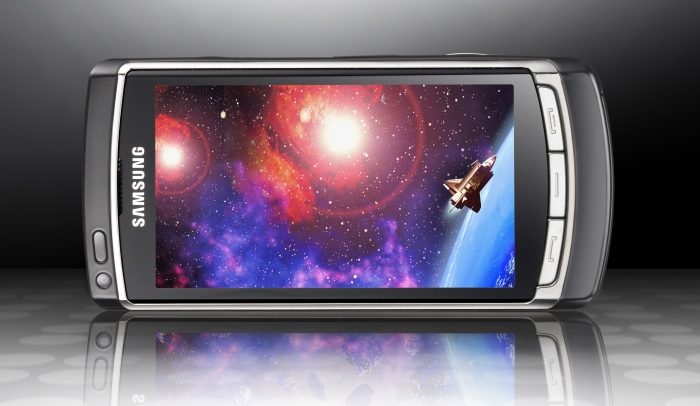
Regarding the HD and media capabilities, Samsung had this to say:
"The HD video recording feature enables you to capture precious moments
in HD (720p) quality, enjoy HD content on HD TV via DLNA technology and
share real-time live video as users shoot it via qik.com. The 16: 9
screen of QHD display with 16M colour and dual stereo speaker reveal a
whole new world of mobile multimedia experiences on the move, enabling
users to enjoy SD (Standard Definition)/HD (High Definition) videos in
cinema-scale quality with caption. Brilliant Convergence Allied to the
industry-leading 8MP camera which allows you take digital
camera-quality photographs on your phone, the Samsung Omnia HD ensures
you capture the best possible photographs of your friends and family."
Raw specs:
- 8 Megapixel CMOS + CIF, Auto-Focus / Power LED Flash / Face
Detection/Smile Shot / Blink Shot / Panorama Shot Video : DivX / XviD /
H.263 / H.264 / WMV / MPEG4, RV 24fps@HD(1280 x 720p)
- Video recording DLNA & HD TV out (DLNA dongle needed) Video
Editing: Trim video / Audio dubbing / Live dubbing / Add subtitle /
Image capture
- Audio : FM Radio with RDS MP3/ AAC / AAC+ / eAAC+ / WMA / RA Dual Stereo Speaker & DNSe 2.0
- Other sensors: Proximity, Light Sensor, Compass, Accelerometer
- Size : 123 x 58 x 12.9
- Battery : 1500 mAh
- HSUPA 5.76Mbps and HSDPA 7.2Mbps
- 3.7" AMOLED, 36 by 640 pixels Auto-Rotating Display
- GPS with integrated compass "makes this suitable for both
pedestrians and drivers, and the navigation touch control and voice
guidance via dual stereo speaker provide drivers with easy and safe
navigation."
- Available in 8GB and 16GB internal capacity options), plus microSD expansion
- Intuitive "3D interface"
- "Samsung Mobile Widget delivers up-to-date information of your
choice with just one touch, creating a personalized interface with
which to access the infinite wealth of web content."
Steve Litchfield, All About Symbian, 11.20am Feb 16th 2009
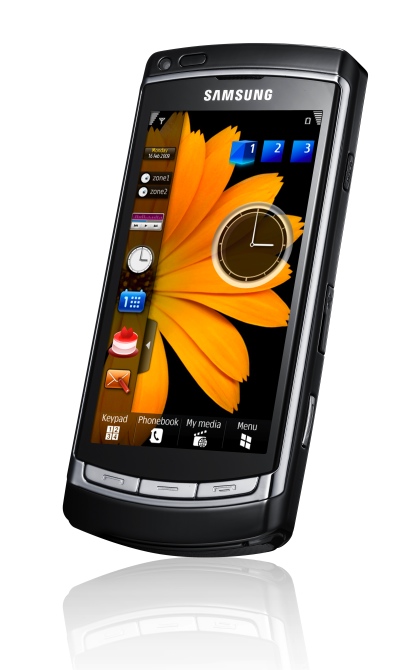
Rafe and I intend to find out - watch this space for detailed
reports from Rafe on the Omnia's interface and software bundle, plus
exclusive video previews from us both.
|